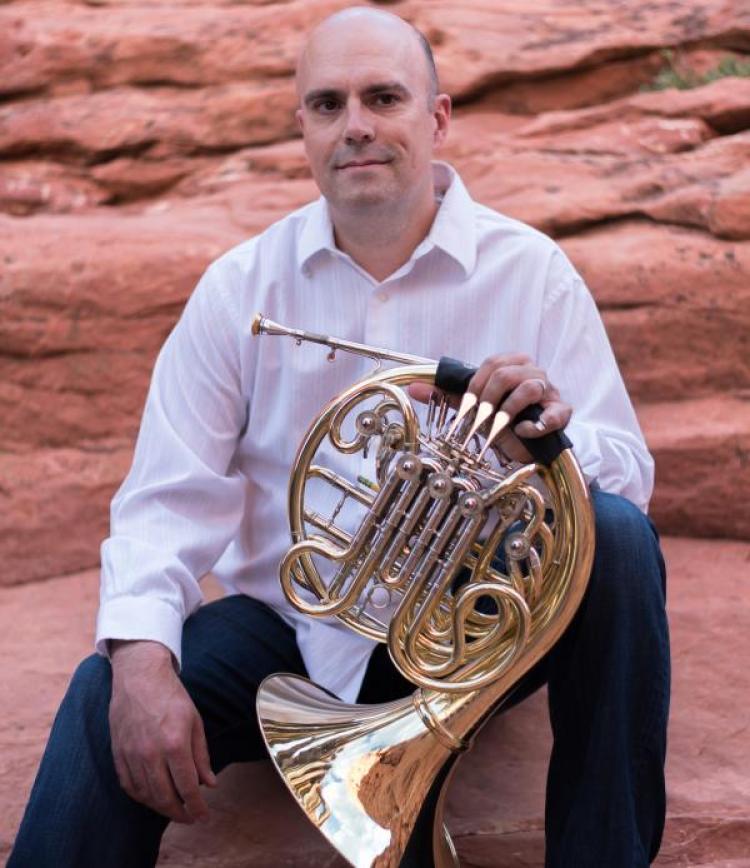Music faculty, students take notes from TikTok for stay-at-home performance
[video:https://www.youtube.com/watch?v=LdFRmfvqLDU&feature=youtu.be]
Concert halls are empty. Summer festivals are canceled. If French horn performance is not only your passion, but your job, like it is for CU Boulder College of Music professor Michael Thornton, playing to an empty armchair gets boring pretty fast.
To compensate, Thornton and some of the CU Horn Studio took their classical musical chops to the modern world of social media. They pulled inspiration from the wildly popular platform TikTok, which often showcases musical remixes and signature dances.
The studio’s video features CU Boulder students and faculty, Colorado Symphony Orchestra members, kids and even a golden retriever performing dance moves to their rendition of "Hunter’s Chorus" from the Opera Der Freischutz.
For Thornton, TikTok-style choreography wasn’t a foreign concept.
With two daughters, ages 11 and 14, Thornton was intimately familiar with the app’s signature dance style and even became an active participant in his daughters’ videos.
“I learned three of the really popular TikTok dances,” Thornton said. “Most of the time, my job is to do them really badly, and they just laugh at me while it’s happening."
COVID-19 in the musical world
When he’s not moonlighting as an unlikely TikTok star, Thornton teaches horn at CU Boulder and serves as principal horn of the Colorado Symphony Orchestra—positions he’s held concurrently for over 20 years.
But never once has Thornton faced a crisis like the coronavirus pandemic, which cancelled or postponed nearly every orchestral performance in the nation and forced professors to adapt their lesson plans for remote learning.
“When the pandemic hit, my first response was to ask, ‘How do we do meaningful things in this virtual space?’” Thornton said.
So in the spirit of social distancing, Thornton and his colleagues performed a horn rendition of "Don’t Stand So Close to Me" by The Police and published the video on the Colorado Symphony’s YouTube and Facebook pages.
The video went viral and The Police even posted the video on their Facebook page.
The initial success prompted Thornton to enlist his students to participate in new videos.
“We felt it was important to show our students that we weren’t afraid to take risks in the available environment and that they should do the same,” Thornton said. “Art doesn’t stop because one platform isn’t available. You have to find the next platform.”
TikTok for non-teenagers

Michael Thornton: professor of horn.
Although TikTok typically caters to young adults aged 16-24, Thornton saw the platform’s potential for a wider audience.
“Our demographics are probably the parents and grandparents of TikTok kids, but they may know what the app is because their kids have been doing it,” Thornton said.
In contrast to Thornton’s previous videos, which featured horn renditions of modern songs, he chose a classical opera piece for this project.
“We thought we’d go the exact opposite direction of most web videos to show that classical music is so cool in its natural form that it can even be used in a TikTok-style video.”
A group effort
Thornton sent sheet music for "Hunter’s Chorus" to participating students and faculty, while his daughters got to work on the choreography. They even created an instructional video so participants could easily learn the dance.
For rising senior Katelyn Wojniak, a French horn player pursuing a degree in music education, the project presented as a unique opportunity.
“Because I’m on TikTok all the time watching videos, it seemed like something fun to do,” Wojniak said. “I thought it was a great way to reach out to an audience we normally wouldn’t reach out to.”
After roughly two weeks of recording, collecting and editing clips, the masterpiece was complete.
Although it was not actually posted on the TikTok platform, the video was published on the College of Music’s Facebook page.
Rightful recognition
Thornton submitted the video for the Center of Arts & Humanities Shelter-in-Place microgrant—an award that recognizes art projects that went above and beyond to engage students amid remote learning.
Of the 144 projects submitted across campus, the Horn Studio’s video won.
“What that says to me, and what I appreciate so much, is that recognition that what we’re doing is viable and important during this time,” Thornton said.
For students like Wojniak, who hope to teach music to future generations, the recognition demonstrated the importance of exploring new mediums.
“I can definitely see myself creating videos like this with my students, I think it would be a great educational resource,” Wojniak said.
But Thornton doesn’t plan on stopping there.
“As a studio, we are going to keep putting out content, keep trying to connect with people and create meaningful art.”


